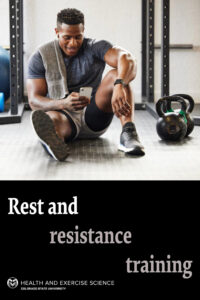 Purposeful exercise requires thoughtfulness; however, our exercise quality and process are often impacted by having a limited amount of time. You need to optimize your exercise so you get the most benefit, most efficiently. One popular exercise modality that provides well-researched benefits in a shorter time frame is resistance training. Resistance training is any mode of training that uses a force to counter the movement, such as using resistance bands, free weights, weight machines, or similar exercises. An overlooked factor of resistance training, however, is the importance of the rest intervals in between each exercise. Without prior knowledge, you may find it difficult to decide how long to rest in between your sets of repetitions, and how often. Ultimately, it depends on what you are looking to gain through resistance training to help guide your decision on your rest quantity. You should become familiar with these three goals when determining your proper rest interval: muscular growth, strength, and endurance. If you want to optimize these, you need to dial in your rest intervals.
Purposeful exercise requires thoughtfulness; however, our exercise quality and process are often impacted by having a limited amount of time. You need to optimize your exercise so you get the most benefit, most efficiently. One popular exercise modality that provides well-researched benefits in a shorter time frame is resistance training. Resistance training is any mode of training that uses a force to counter the movement, such as using resistance bands, free weights, weight machines, or similar exercises. An overlooked factor of resistance training, however, is the importance of the rest intervals in between each exercise. Without prior knowledge, you may find it difficult to decide how long to rest in between your sets of repetitions, and how often. Ultimately, it depends on what you are looking to gain through resistance training to help guide your decision on your rest quantity. You should become familiar with these three goals when determining your proper rest interval: muscular growth, strength, and endurance. If you want to optimize these, you need to dial in your rest intervals.
Muscular Growth
Muscular growth, or hypertrophy, is a key factor in fitness, as increasing your skeletal muscle mass is vital because muscle stores glucose. If you can increase your muscle growth, you give yourself greater control over the glucose levels in your body. Resistance training is our best-known method to increase skeletal muscle growth. Studies show that for hypertrophy, the rest intervals between resistance exercises should be somewhere between 60 and 90 seconds. Some studies show around two to three minutes can be beneficial for hypertrophy as well.
Muscular Strength
Increasing muscular strength is not increasing the amount of muscle mass you have, which is muscular growth, but instead, the amount of force the muscle can exert. Rest intervals to optimize strength need to be longer, between three and five minutes. The amount of weight that is being lifted should be taxing on the body. There will be fewer sets and repetitions involved in strength-specific training, but more rest is needed to allow the body to come back to homeostasis. Improving muscular strength has been associated with longevity as demonstrated in studies regarding grip strength and biomarkers.
Muscular Endurance
Muscular endurance is the muscle’s ability to maintain contractions and force exertion over a long period. Because of this, you do not want a long rest interval, as you want the muscle to be in a state of fatigue so it can adapt to that need. The rest interval for these exercises should be between 30 and 60 seconds. We can attest to the importance of muscular endurance in its role in cardiovascular health.
Check-In
Whatever you are trying to achieve with your resistance training, you should pay attention to outside factors affecting your training session. You need to treat every session individually. For example, sleep, stress, and nutrition can greatly impact how you train on a particular day. If any of these areas are suffering, it could inhibit your ability to train at your maximum potential. You need to check in with yourself before, during, and after training to make necessary changes. It is okay to take more rest on a day when you do not feel up to your best self.
Rest intervals may seem trivial, but they can make a significant difference in your resistance training if you treat them intentionally.
Monica Kinney is the program manager of the Adult Fitness Program in the Department of Health and Exercise Science at Colorado State University. Adult Fitness offers exercise opportunities for employees of CSU as well as community members while providing hands-on learning experiences for health promotion students. To learn more, see the Adult Fitness Program website.
Sources:
- https://www.scienceinsport.com/sports-nutrition/muscular-endurance-explained/
- Jozo Grgic, Bruno Lazinica, Pavle Mikulic, James W. Krieger & Brad Jon Schoenfeld (2017) The effects of short versus long inter-set rest intervals in resistance training on measures of muscle hypertrophy: A systematic review, European Journal of Sport Science, 17:8, 983-993, DOI: 10.1080/17461391.2017.1340524
- Bohannon RW. Grip Strength: An Indispensable Biomarker For Older Adults. Clin Interv Aging. 2019 Oct 1;14:1681-1691. doi: 10.2147/CIA.S194543. PMID: 31631989; PMCID: PMC6778477
- Freitas de Salles, B., Simão, R., Miranda, F. et al. Rest Interval between Sets in Strength Training. Sports Med 39, 765–777 (2009). https://doi.org/10.2165/11315230-000000000-00000
- Schoenfeld, Brad & Pope, Zachary & Benik, Franklin & Hester, Garrett & Sellers, John & Nooner, Josh & Schnaiter, Jessica & Bond-Williams, Katherine & Carter, Adrian & Ross, Corbin & Just, Brandon & Henselmans, Menno & Krieger, James. (2015). Longer Interset Rest Periods Enhance Muscle Strength and Hypertrophy in Resistance-Trained Men. Journal of Strength and Conditioning Research. 30. 1. 10.1519/JSC.0000000000001272.